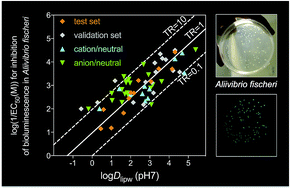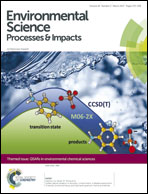General baseline toxicity QSAR for nonpolar, polar and ionisable chemicals and their mixtures in the bioluminescence inhibition assay with Aliivibrio fischeri†
Abstract
The Microtox assay, a bioluminescence inhibition assay with the marine bacterium Aliivibrio fischeri, is one of the most popular bioassays for assessing the cytotoxicity of organic chemicals, mixtures and environmental samples. Most environmental chemicals act as baseline toxicants in this short-term screening assay, which is typically run with only 30 min of exposure duration. Numerous Quantitative Structure–Activity Relationships (QSARs) exist for the Microtox assay for nonpolar and polar narcosis. However, typical water pollutants, which have highly diverse structures covering a wide range of hydrophobicity and speciation from neutral to anionic and cationic, are often outside the applicability domain of these QSARs. To include all types of environmentally relevant organic pollutants we developed a general baseline toxicity QSAR using liposome–water distribution ratios as descriptors. Previous limitations in availability of experimental liposome–water partition constants were overcome by reliable prediction models based on polyparameter linear free energy relationships for neutral chemicals and the COSMOmic model for charged chemicals. With this QSAR and targeted mixture experiments we could demonstrate that ionisable chemicals fall in the applicability domain. Most investigated water pollutants acted as baseline toxicants in this bioassay, with the few outliers identified as uncouplers or reactive toxicants. The main limitation of the Microtox assay is that chemicals with a high melting point and/or high hydrophobicity were outside of the applicability domain because of their low water solubility. We quantitatively derived a solubility cut-off but also demonstrated with mixture experiments that chemicals inactive on their own can contribute to mixture toxicity, which is highly relevant for complex environmental mixtures, where these chemicals may be present at concentrations below the solubility cut-off.

- This article is part of the themed collection: QSARs and computational chemistry methods in environmental chemical sciences


 Please wait while we load your content...
Please wait while we load your content...